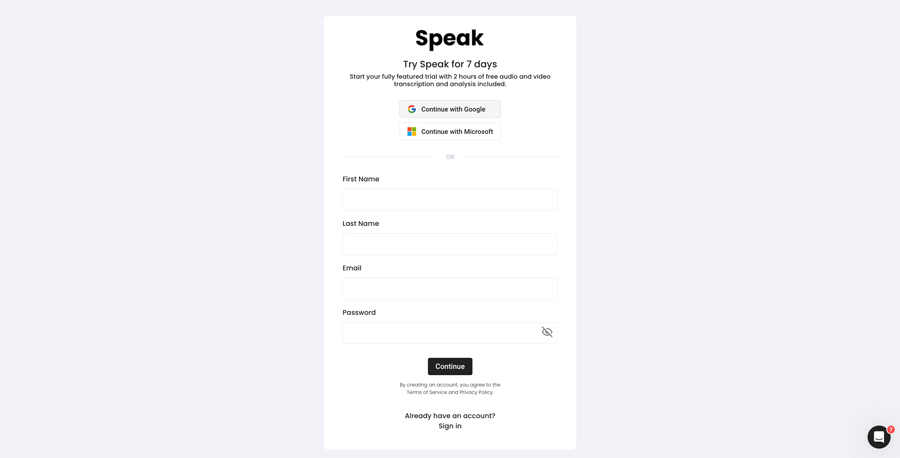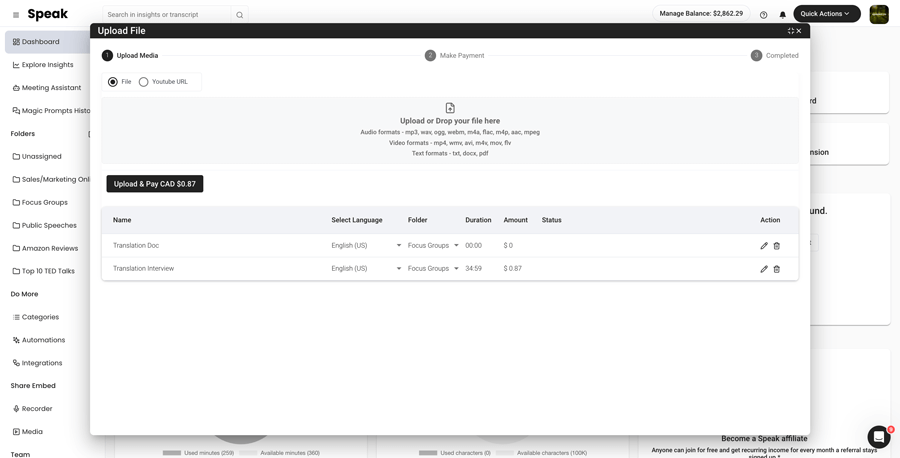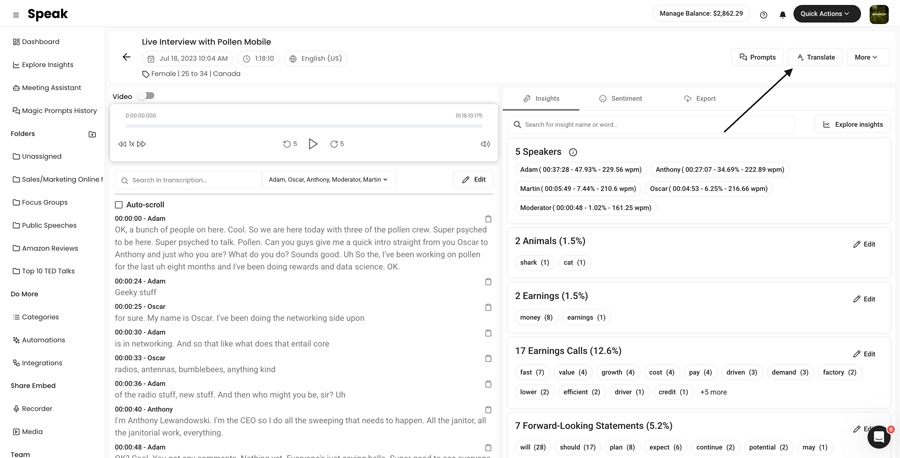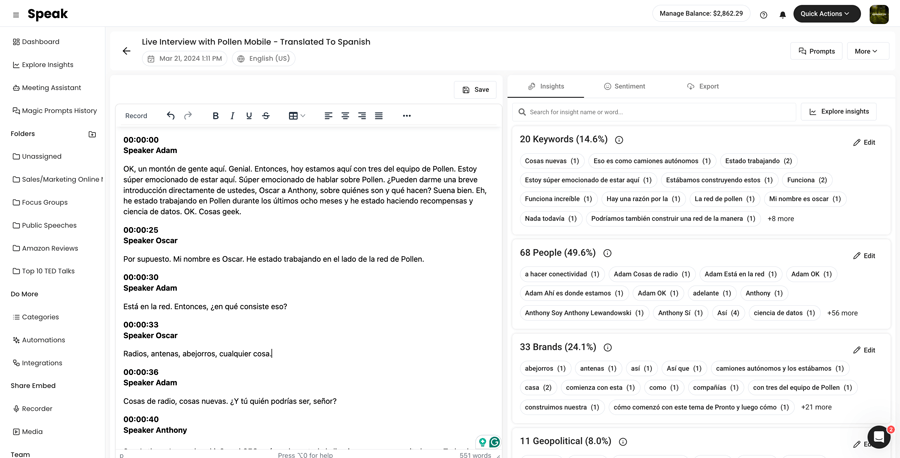How To Translate Latin to Filipino Tagalog
Translating Latin to Filipino Tagalog is super simple!

Step 1: Register for Speak
Register for Speak using this link.
Once you register, you can instantly begin translating your Latin to Filipino Tagalog file(s).

Step 2: Upload Your Latin file(s)
As soon as you log in, you will be redirected to the dashboard.
Once there, you can select the Quick Action "New Upload".
In Speak, you can seamlessly upload, transcribe and translate audio, video and text files all at once!

Step 3: Translate Your Latin file(s) to Filipino Tagalog
Once the file is uploaded, simply visit your file and select "Translate".
If it is an audio and video file, Speak will ask you if you want to keep the speaker names and timestamps in the translation.
Want to translate many files at once? No problem!
You can view the files you want to automatically translate from Latin to Filipino Tagalog from the folder level and instantly translate as many files as you need with our artificial intelligence translation in just a few clicks.

Step 4: That's It! View, Analyze, Modify & Export Your New Filipino Tagalog file(s)
Once the translation is done, you will be alerted and you will see a new document in the same folder your original file is in.
The file will be named the same but with a dash indicating that it is the translated version.
Need support with your Latin translation?
We are always here and happy to help at Speak!
Just send us a message on live chat on the bottom right corner and we will ensure you are set up for success.
Interested in translating Latin or other languages to different languages? View our entire list of supported translation languages here.
Automatic, accurate, instant AI translation from Latin to Filipino Tagalog is here for you.
Register for Speak using this link and begin translating Latin to Filipino Tagalog today.
Unlock the Power of Language: Translate Latin to Filipino Tagalog with AI
Imagine unlocking ancient wisdom or reaching a broader audience by bridging the gap between the classical language of Latin and the vibrant, dynamically evolving Filipino Tagalog. As globalization tightens its grip on the world, the ability to seamlessly translate between languages becomes invaluable. In this era, where traditional and digital realms collide, Speak Ai introduces a groundbreaking solution that transforms language barriers into bridges, particularly from Latin to Filipino Tagalog.
Understanding the Essence of Latin and Filipino Tagalog Translation
Latin, once the lingua franca of the Roman Empire, now thrives in academic, theological, and historical studies. Conversely, Filipino Tagalog, a language spoken by millions in the Philippines and around the globe, vibrates with the pulse of daily life, culture, and identity in the Philippines. Bridging these two languages opens a myriad of opportunities for educators, researchers, businesses, and individuals alike.
Revolutionizing Communication: Benefits of AI-Powered Translation
- Cost and Time Efficiency: Traditional translation processes can be time-consuming and costly. AI translation dramatically reduces these constraints, offering quick and affordable alternatives without sacrificing quality.
- Accuracy and Consistency: Speak Ai leverages advanced NLP and large language models to ensure high accuracy levels and consistency across all translations, from Latin to Filipino Tagalog and vice versa.
- Enhanced Accessibility: By translating texts, audio, and video content automatically, we bring historical texts, academic materials, and other resources closer to Filipino Tagalog speakers, enhancing understanding and engagement.
The Speak Ai Advantage: Beyond Translation
At Speak Ai, we're not just about translation. Our platform is an integrated suite of tools designed for automatic transcription, analysis, and visualization of data. With a 4.9 rating on G2 and over 150K users, our AI Meeting Assistant feature seamlessly works with platforms like Microsoft Teams, Zoom, Google Meet, and Webex to make meeting insights actionable and accessible.
Applications and Real-World Use Cases
From academic research unlocking ancient texts to businesses aiming to expand their market reach in the Philippines, the applications of translating Latin to Filipino Tagalog are vast. Educators can make historical and theological materials more accessible, while businesses can tailor their marketing materials to resonate better with the Filipino-speaking audience.
Driving Global Connection
In a world where the past and the present constantly interact, making Latin accessible in Filipino Tagalog not only preserves historical integrity but also enriches the cultural and educational landscapes. It fosters a deeper connection and understanding across time and space, proving indispensable for researchers and global businesses alike.
Latin and Filipino Tagalog: Bridging Histories and Cultures
Locations Where Latin and Filipino Tagalog Thrive
Latin, though no longer a vernacular language, remains significant in Vatican City, used in Roman Catholic liturgies and by scholars across the world. Filipino Tagalog, on the other hand, is predominantly spoken in the Philippines, home to over 109 million people, and by the Filipino diaspora worldwide.
Fun Facts: From Ancient Rome to the Philippine Archipelago
- Latin terms and phrases persist in legal, medical, and scientific terminologies, showcasing its enduring legacy.
- Filipino Tagalog incorporates words from Spanish, Malay, English, and Chinese, reflecting centuries of trade and colonial history.
Differences and Similarities: Linguistic Tapestry
While Latin and Filipino Tagalog hail from different language families—Indo-European and Austronesian, respectively—they share linguistic features influenced by history, such as loanwords. Latin's structured grammar contrasts with Filipino Tagalog's flexible syntax, but both languages richly contribute to their respective cultures and identities.
The Speak Ai Difference
At Speak Ai, we are dedicated to breaking down language barriers, translating ancient wisdom and current dialogues from Latin to Filipino Tagalog. Our state-of-the-art AI, integrated NLP, and large language models are not just about translation but about understanding and connecting. Dive into the new era of language translation and let Speak Ai be your guide to new horizons of communication and insight.
Embrace the future of translation and unlock the full potential of your projects and endeavors. Join us today and start your journey with Speak Ai, where languages converge, histories meet, and stories are told anew.
---
### Q&A:
**What locations are Latin and Filipino Tagalog popular?**
Latin, though primarily a liturgical language today, remains prominent within educational, legal, and scientific communities globally, particularly in Vatican City where it's still an official language. Filipino Tagalog is widely spoken in the Philippines, which has a population exceeding 109 million, and by the Filipino diaspora spread across the globe, from the United States to the Middle East and beyond.
**What are some fun facts about Latin and Filipino Tagalog?**
- Latin has given the English language numerous words, around 60% of all English words have Greek or Latin roots.
- Filipino Tagalog contains words from various languages including Spanish, English, Malay, and Chinese, showcasing the Philippines' rich history of interactions and colonization.
- The Philippines is one of the largest English-speaking countries, yet Filipino Tagalog proudly retains its position as the national language, highlighting the country's linguistic diversity.
**What are the differences and similarities between Latin and Filipino Tagalog?**
Differences:
- Latin belongs to the Indo-European language family, whereas Filipino Tagalog is part of the Austronesian family.
- The structure of Latin is highly inflected, showcasing a complex system of verb conjugations and noun declensions, whereas Filipino Tagalog follows a more straightforward analytic syntax with focus on affixes to indicate grammatical context.
Similarities:
- Both languages have enriched their vocabularies with loanwords from other languages because of historical conquests and trade.
- Each language plays a crucial role in the identity and cultural heritage of its speakers, carrying the weight of a rich historical past into modernity.
Translate Latin To These Other Supported Languages:
- Translate Latin-to-Afrikaans
- Translate Latin-to-Albanian
- Translate Latin-to-Amharic
- Translate Latin-to-Arabic (Egypt)
- Translate Latin-to-Arabic (Iraq)
- Translate Latin-to-Arabic (Israel)
- Translate Latin-to-Arabic (Jordan)
- Translate Latin-to-Arabic (Kuwait)
- Translate Latin-to-Arabic (Lebanon)
- Translate Latin-to-Arabic (Oman)
- Translate Latin-to-Arabic (Palestinian Authority)
- Translate Latin-to-Arabic (Qatar)
- Translate Latin-to-Arabic (Saudi Arabia)
- Translate Latin-to-Arabic (Syrian Arab Republic)
- Translate Latin-to-Arabic (United Arab Emirates)
- Translate Latin-to-Arabic Modern Standard (Bahrain)
- Translate Latin-to-Armenian
- Translate Latin-to-Assamese
- Translate Latin-to-Aymara
- Translate Latin-to-Azerbaijani
- Translate Latin-to-Bambara
- Translate Latin-to-Basque
- Translate Latin-to-Belarusian
- Translate Latin-to-Bengali
- Translate Latin-to-Bhojpuri
- Translate Latin-to-Bosnian
- Translate Latin-to-Bulgarian
- Translate Latin-to-Catalan
- Translate Latin-to-Cebuano
- Translate Latin-to-Chinese (Simplified)
- Translate Latin-to-Chinese (Traditional)
- Translate Latin-to-Corsican
- Translate Latin-to-Croatian
- Translate Latin-to-Czech
- Translate Latin-to-Danish
- Translate Latin-to-Dari
- Translate Latin-to-Dhivehi
- Translate Latin-to-Dogri
- Translate Latin-to-Dutch
- Translate Latin-to-English
- Translate Latin-to-English (Australia)
- Translate Latin-to-English (Indian)
- Translate Latin-to-English (Irish)
- Translate Latin-to-English (New Zealand)
- Translate Latin-to-English (Scottish)
- Translate Latin-to-English (South African)
- Translate Latin-to-English (United Kingdom)
- Translate Latin-to-English (United States)
- Translate Latin-to-Esperanto
- Translate Latin-to-Estonian
- Translate Latin-to-Ewe
- Translate Latin-to-Farsi (Persian)
- Translate Latin-to-Filipino Tagalog
- Translate Latin-to-Finnish
- Translate Latin-to-French
- Translate Latin-to-French (Canada)
- Translate Latin-to-Frisian
- Translate Latin-to-Galician
- Translate Latin-to-Georgian
- Translate Latin-to-German
- Translate Latin-to-German (Swiss)
- Translate Latin-to-Greek
- Translate Latin-to-Guarani
- Translate Latin-to-Gujarati
- Translate Latin-to-Haitian Creole
- Translate Latin-to-Hausa
- Translate Latin-to-Hawaiian
- Translate Latin-to-Hebrew
- Translate Latin-to-Hindi
- Translate Latin-to-Hmong
- Translate Latin-to-Hungarian
- Translate Latin-to-Icelandic
- Translate Latin-to-Igbo
- Translate Latin-to-Ilocano
- Translate Latin-to-Indonesian
- Translate Latin-to-Irish
- Translate Latin-to-Italian
- Translate Latin-to-Japanese
- Translate Latin-to-Javanese
- Translate Latin-to-Kannada
- Translate Latin-to-Kazakh
- Translate Latin-to-Khmer
- Translate Latin-to-Kinyarwanda
- Translate Latin-to-Konkani
- Translate Latin-to-Korean
- Translate Latin-to-Krio
- Translate Latin-to-Kurdish
- Translate Latin-to-Kurdish (Sorani)
- Translate Latin-to-Kyrgyz
- Translate Latin-to-Lao
- Translate Latin-to-Latin
- Translate Latin-to-Latvian
- Translate Latin-to-Lingala
- Translate Latin-to-Lithuanian
- Translate Latin-to-Luganda
- Translate Latin-to-Luxembourgish
- Translate Latin-to-Macedonian
- Translate Latin-to-Maithili
- Translate Latin-to-Malagasy
- Translate Latin-to-Malay
- Translate Latin-to-Malayalam
- Translate Latin-to-Maltese
- Translate Latin-to-Maori
- Translate Latin-to-Marathi
- Translate Latin-to-Meiteilon (Manipuri)
- Translate Latin-to-Mizo
- Translate Latin-to-Mongolian
- Translate Latin-to-Myanmar (Burmese)
- Translate Latin-to-Nepali
- Translate Latin-to-Norwegian
- Translate Latin-to-Nyanja (Chichewa)
- Translate Latin-to-Odia (Oriya)
- Translate Latin-to-Oromo
- Translate Latin-to-Pashto
- Translate Latin-to-Persian
- Translate Latin-to-Polish
- Translate Latin-to-Portuguese
- Translate Latin-to-Portuguese (Brazilian)
- Translate Latin-to-Portuguese (Portugal)
- Translate Latin-to-Punjabi
- Translate Latin-to-Quechua
- Translate Latin-to-Romanian
- Translate Latin-to-Russian
- Translate Latin-to-Samoan
- Translate Latin-to-Sanskrit
- Translate Latin-to-Scots Gaelic
- Translate Latin-to-Sepedi
- Translate Latin-to-Serbian
- Translate Latin-to-Sesotho
- Translate Latin-to-Shona
- Translate Latin-to-Sindhi
- Translate Latin-to-Sinhala
- Translate Latin-to-Sinhala (Sinhalese)
- Translate Latin-to-Slovak
- Translate Latin-to-Slovenian
- Translate Latin-to-Somali
- Translate Latin-to-Spanish
- Translate Latin-to-Spanish (Mexico)
- Translate Latin-to-Sundanese
- Translate Latin-to-Swahili
- Translate Latin-to-Swedish
- Translate Latin-to-Tajik
- Translate Latin-to-Tamil
- Translate Latin-to-Tatar
- Translate Latin-to-Telugu
- Translate Latin-to-Thai
- Translate Latin-to-Tigrinya
- Translate Latin-to-Tsonga
- Translate Latin-to-Turkish
- Translate Latin-to-Turkmen
- Translate Latin-to-Twi (Akan)
- Translate Latin-to-Ukrainian
- Translate Latin-to-Urdu
- Translate Latin-to-Uyghur
- Translate Latin-to-Uzbek
- Translate Latin-to-Vietnamese
- Translate Latin-to-Welsh
- Translate Latin-to-Xhosa
- Translate Latin-to-Yiddish
- Translate Latin-to-Yoruba
- Translate Latin-to-Zulu



